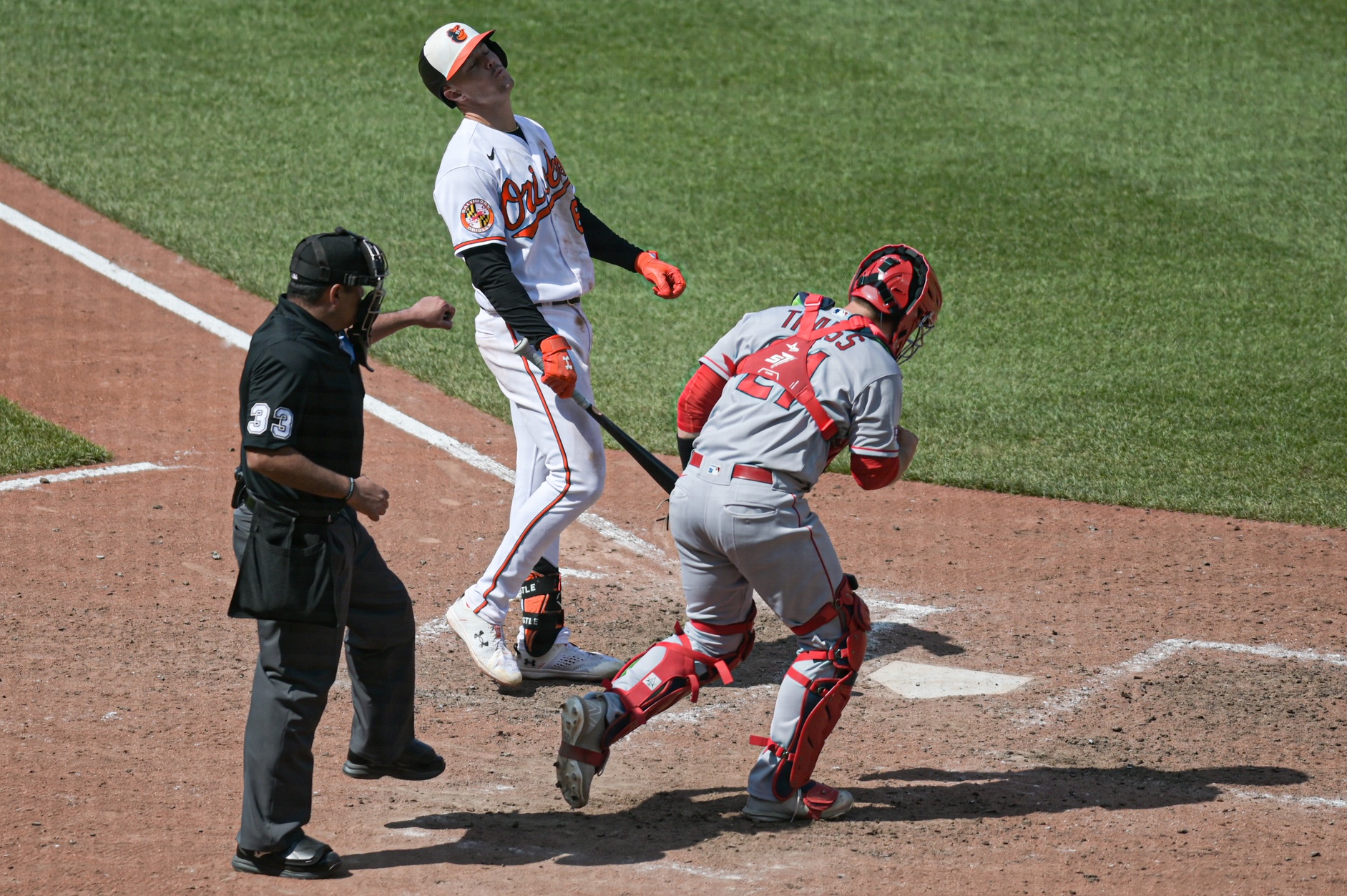
May 18, 2023; Baltimore, Maryland, USA; Los Angeles Angels catcher Matt Thaiss (21) pumps his fist as home plate umpire Nestor Ceja calls Baltimore Orioles first baseman Ryan Mountcastle (6) out on strike to end the game at Oriole Park at Camden Yards. Mandatory Credit: Tommy Gilligan-USA TODAY Sports
For lack of a better term, let’s call it the “Pressure Dynamic.”
Hypothetical situation: Runners on first and second with none or one out. Opposing pitcher loads the bases with a four- or five-pitch walk. Young Oriole hitter steps up to the plate and swings at a first pitch that is out of the strike zone and either pops up, grounds into a double play or goes on to strike out on three or four pitches.
If this scenario sounds pretty familiar, it’s because something like it has happened quite often over the past couple of weeks. The usually-patient Oriole hitters go into aggressive mode at just the wrong times and squander some big opportunities.
Full disclosure: If this sounds like nit-picking, it probably is, since the Orioles have played very well through the first quarter of the season and are among the better offensive teams in either league. Still, it’s something to think about as they prepare to face some really good teams with really good pitching.
The main reason the Orioles have been so effective – especially against some very good pitchers – is because they have generally done a great job of running up pitch counts, accepting walks and getting after opposing bullpens. When they aren’t successful, it’s because they’ve been stymied with runners in scoring position.
Some of that is just bad luck. Some of it is tough pitching. But sometimes – particularly in bases-loaded situations – it’s a matter of a young hitter feeling pressure to deliver a huge hit and not understanding that the pitcher is the one who’s supposed to be feeling the heat.
Real example: I’d rather not single out young utilityman Terrin Vavra, since he’s making a solid contribution off the bench, but I’ll use his at-bat with the bases loaded in Wednesday night’s game because the Orioles went on to score an uplifting victory anyway and it seems like a classic example of what we’re examining here.
The Orioles loaded the bases after Gunnar Henderson tripled, Austin Hays walked and the Angels misplayed a sacrifice bunt by Adam Frazier. Vavra came to the plate and lunged at a low slider for strike one and got a changeup down and in, which he bounced back to the mound for the dreaded 1-2-3 double play.
Not a mortal sin to be sure. Vavra wanted to make the most out of his three swings and ended up making the least. Teammate Ryan Mountcastle is a notorious first-pitch swinger and has little to show for several recent at-bats with the bases loaded.
Which brings me back to the pressure dynamic. When the bases are loaded with less than two outs – and particularly when the bases are loaded with no outs – it’s the pitcher who is in trouble, not the hitter. The best thing that could possibly happen for the pitcher in that situation is for the hitter to chase a first pitch that is breaking out of the zone or a strike that isn’t very hittable, so why do so many young hitters do just that?
Well, because they feel pressure to make the most out of a huge at-bat and don’t want to fall behind in the count. What often happens instead is that they simply surrender a third of the leverage in that at-bat by swinging through a pitch that would have been a ball or making weak contact on a well-located strike.
Sure, it’s possible to ambush a pitcher who leaves the first pitch in the middle of the plate, but good pitchers – even struggling good pitchers – don’t usually do that. That’s why they’re good pitchers.
It’s easy to write that kind of swing off to an “aggressive” approach, but there are times to be aggressive and times to play the game within the game, and we’re not just talking about RISP situations. The Orioles had a situation recently in which Cedric Mullins walked on four pitches to lead off the first inning and three pitches later the inning was over.
If a pitcher looks like he might struggle, it’s a pretty good idea to let him try. The Orioles have done that for most of this uplifting early season, and they have found ways to outlast some great pitchers who weren’t struggling but ran out of pitch count and left the door open for a late-inning comeback.
This is a very good young team that has a chance to get even better, but the going is about to get tougher and the Orioles need to get more out of their most promising offensive situations.
BALTIMORE—Orioles executive vice president/general manager Mike Elias is disappointed with how the 2025 season has…
Question: The Orioles' minor league teams are struggling mightily, both pitching and hitting wise. What…
BALTIMORE—These days, I’m often asked about the Orioles’ clubhouse mood. How is it? Do players…
Question: James McCann did such a good job last year as the Orioles backup catcher.…
BALTIMORE- What happened? After an awful defeat, the Orioles bounced back and beat the New…
In 1953, the year before they moved to Baltimore and became the Orioles, the St.…